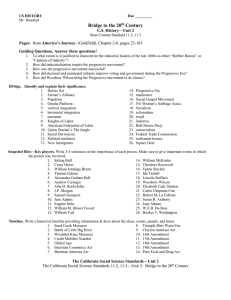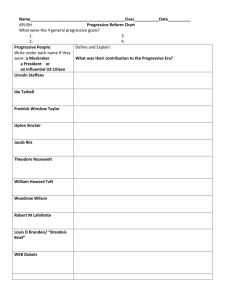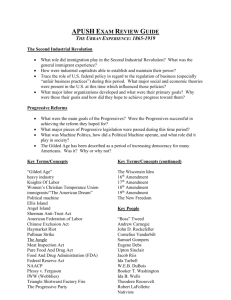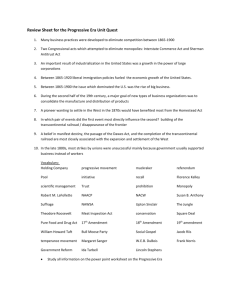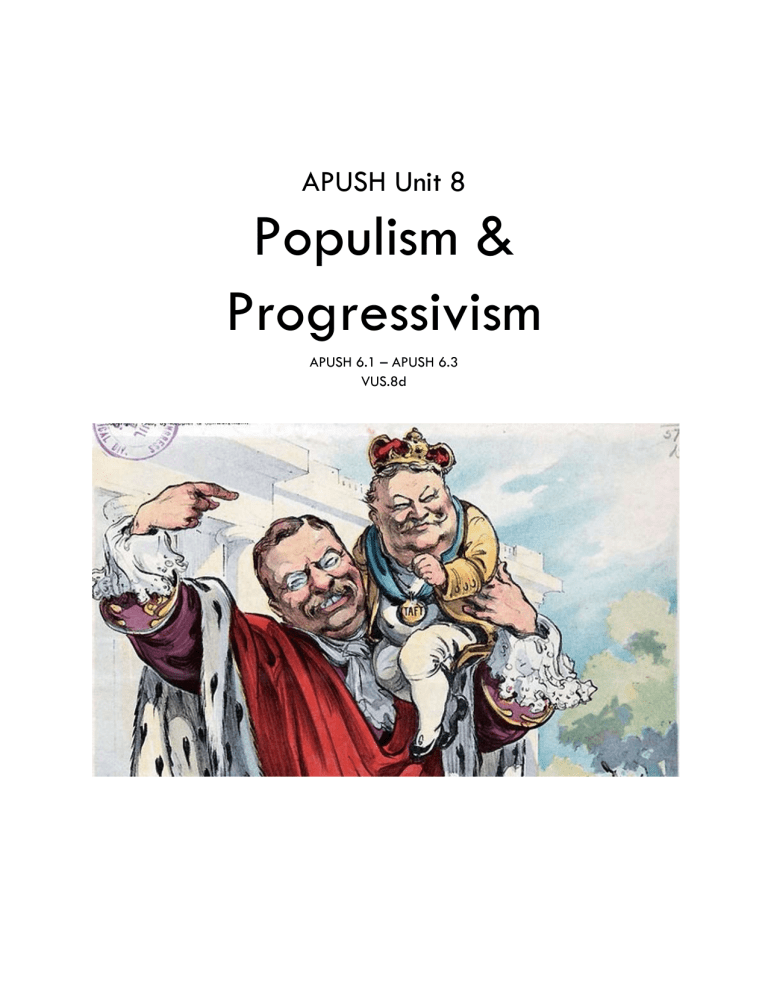
APUSH Unit 8 Populism & Progressivism APUSH 6.1 – APUSH 6.3 VUS.8d The Labor Movement Labor and management battled for control over wages and working conditions, with workers organizing local and national unions and directly confronting corporate power. As cities grew substantially in both size and in number, some segments of American society enjoyed lives of extravagant “conspicuous consumption,” while many others lived in relative poverty. Large corporations came to dominate the U.S. economy as it increasingly focused on the production of consumer goods, driven by new technologies and manufacturing techniques. The industrial workforce expanded through migration across national borders and internal migration, leading to a more diverse workforce, lower wages, and an increase in child labor. Racism and nativism often weakened the effectiveness of the labor movement. Corporations and the federal government were usually hostile to organized labor and often used force to crush strikes. As a result, organized labor met with only limited success. Labor Goals & Tactics Wages, hours & working conditions “Eight-hour day” movement Skilled workers vs. unskilled workers Craft unions vs. trade unions Nativism Chinese Exclusion Act, 1882 Abolition of child labor Strike Wildcat strike Collective bargaining Closed shop Mediation & arbitration Management Goals & Tactics Yellow dog contract Lockout “Scabs” Pinkertons Blacklist Sherman Antitrust Act injunctions against labor unions Open shop Organizations, Leaders & Events National Labor Union Knights of Labor Terence V. Powderly Mother Jones President Rutherford B. Hayes Great Railroad Strike, 1877 Haymarket Square Riot (Haymarket Affair), 1886 American Federation of Labor Samuel Gompers Carnegie Steel Company Homestead Strike, 1892 Coxey’s Army, 1894 Company towns Debt peonage Pullman, Illinois President Grover Cleveland Pullman Strike, 1894 President Theodore Roosevelt United Mine Workers (UMW) Anthracite Coal Strike, 1902 International Ladies’ Garment Workers Union (ILGWU) Florence Kelly Triangle Shirtwaist Fire, 1911 Ludlow Massacre, 1914 Radical Labor Karl Marx & Friedrich Engels The Communist Manifesto, 1848 Edward Bellamy Looking Backward, 1888 Utopian socialism Socialist Party Eugene Debs’ presidential campaigns, 1900-1920 Jack London The Iron Heel Industrial Workers of the World (IWW/“Wobblies”) “One Big Union” Rise and Fall of Populism The growth of corporate power in agriculture and economic instability in the farming sector inspired activists to create the People’s (Populist) Party, which called for political reform and a stronger governmental role in the American economic system. Farmers adapted to the new realities of mechanized agriculture and dependence on the evolving railroad system by creating local and regional organizations that sought to resist corporate control of agricultural markets. Western farmers fought largely in vain against the transformation of American agriculture and the larger economy. Many of the ideas proposed by the rural Populist movement were later adopted and successfully implemented by the urban Progressive movement. Mechanization of agriculture/ “farm as a factory” Debt Deflation Drought Locusts Trusts Tariffs Railroad rates Oliver Kelley The Grange (Patrons of Husbandry) Social gatherings Cooperatives Greenbacks Greenback Labor Party Granger laws (regulation of railroads) Munn v. Illinois, 1877 Intrastate commerce Wabash v. Illinois, 1886 Interstate commerce Interstate Commerce Act, 1887 Sherman Antitrust Act, 1890 U.S. v. E.C. Knight Co., 1895 Interstate Commerce Commission Farmers’ Alliances: Northern, Southern, Colored Mary Elizabeth Lease James B. Weaver Coxey Armies Populist (People’s) Party Election of 1892 James B. Weaver Omaha Platform, 1892 Abolition of the national bank Direct democracy Direct election of senators Australian (secret) ballot Government ownership (nationalization) of railroads Nativism 8-hour workday Gold, silver & bimetallism Panic of 1893 Election of 1896 William Jennings Bryan “Cross of Gold” Speech “Gold bugs” vs. “silverites” William McKinley Marcus Hanna Campaign finance Dingley Tariff, 1897 Gold Standard Act, 1900 L. Frank Baum The Wonderful Wizard of Oz Frank Norris The Octopus, 1901 The Progressive Movement The Progressive movement achieved sweeping reforms that improved the lives of workers, consumers, women, children and made government more democratic. In the late 1890s and the early years of the 20th century, journalists and Progressive reformers — largely urban and middle class, and often female — worked to reform existing social and political institutions at the local, state, and federal levels by creating new organizations aimed at addressing social problems associated with an industrial society. Progressive reformers responded to economic instability, social inequality, and political corruption by calling for government intervention in the economy, expanded democracy, greater social justice, and conservation of natural resources. Business interests battled conservationists as the latter sought to protect sections of unspoiled wilderness through the establishment of national parks and other conservationist and preservationist measures. The women’s rights movement was both emboldened and divided over the 14th and 15th Amendments to the Constitution. Challenging their prescribed “place,” women activists articulated alternative visions of political, social, and economic equality. Corruption in government — especially as it related to big business — energized the public to demand increased popular control and reform of local, state, and national governments, ranging from minor changes to major overhauls of the capitalist system. A number of critics challenged the dominant corporate ethic in the United States and sometimes capitalism itself, offering alternate visions of the good society through utopianism and the Social Gospel. Progressivism Robert “Fighting Bob” LaFollette “Wisconsin Idea” Academic-public alliance Henry James Pragmatism John Dewey “Learning by doing” Normal schools Chautauqua movement “Social Gospel” (Liberal Protestantism) Middle class Direct democracy Initiative Referendum Recall City managers & commissioners Australian (secret) ballot Primary elections (direct primaries) 17th Amendment Muckrakers Frank Norris The Octopus Lincoln Steffens The Shame of the Cities Jacob Riis How the Other Half Lives Jane Addams Hull House Settlement houses Henry Demarest Lloyd Ida Tarbell The History of Standard Oil Monopolies & trusts Enforcement of the Sherman Antitrust Act (“trust-busting”) Upton Sinclair The Jungle Consumer protection Meat Inspection Act/Pure Food & Drug Act John Spargo The Bitter Cry of the Children Child labor Lochner v. New York, 1905 Loewe v. Lawlor (Danbury Hatters case), 1908 Muller v. Oregon, 1908 “Maternal welfare” International Ladies Garment Workers Union (ILGWU) Florence Kelly Triangle Shirtwaist Fire Labor departments Minimum wage laws Workers compensation Industrial Workers of the World (IWW/“Wobblies”) Socialist Party Eugene Debs Carrie Nation Women’s Christian Temperance Union (WCTU) 18th Amendment Volstead Act Prohibition Victorian morality Comstock Law of 1873 Kate Chopin The Awakening Victoria Woodhull “Free love” Divorce rates Family size Birth control Sterilization programs Women’s suffrage in the west Susan B. Anthony Civil disobedience Carrie Chapman Catt National American Women’s Suffrage Association (NAWSA) Alice Paul National Women’s Party (NWP) Women in factories during World War I 19th Amendment League of Women Voters Sierra Club Audubon Society Frederick Law Olmstead City parks Conservation John Muir Land management Gifford Pinchot National parks Progressive Presidents Presidents Theodore Roosevelt, William Taft and Woodrow Wilson responded to the progressive movement by increasing the role of the federal government in regulating the economy. Theodore Roosevelt Administration Assassination of William McKinley Anthracite Coal Strike United Mine Workers Arbitration “Square Deal” Northern Securities v. U.S., 1904 Enforcement of the Sherman Antitrust Act (“trust-busting”) “Good trusts” vs. “bad trusts” “Big Stick” “Bully pulpit” Meat Inspection Act Pure Food & Drug Act Elkins Act Railroad rebates Hepburn Act Free passes Interstate Commerce Commission Booker T. Washington Conservation John Muir Land management Gifford Pinchot Sierra Club Newlands Reclamation Act National Parks William H. Taft Administration Mann-Elkins Act Payne-Aldrich Tariff Ballinger-Pinchot Affair U.S. v. U.S. Steel 16th Amendment Income tax Election of 1912 Theodore Roosevelt “New Nationalism” Progressive (Bull Moose) Party William H. Taft Republican Party Woodrow Wilson Democratic Party “New Freedom” Eugene Debs Socialist Party Eugene Chafin Prohibition Party Woodrow Wilson Administration World War I Underwood Tariff Tariff reductions Graduated (progressive) income tax Federal Reserve Act Discount (interest) rate Federal Trade Commission (FTC) Clayton Antitrust Act Child Labor Laws Adamson Act 17th Amendment Direct election of senators 18th Amendment Prohibition of alcohol 19th Amendment Women’s suffrage Unit Review: Essential Questions How successful were labor unions in improving the lives of workers in the late 1800s and early 1900s? How did states and the federal government respond to the labor movement? What factors contributed to the rise of the farmers’ movement? To what extent did the Populist movement achieve its goals? How did the excesses of the Gilded Age contribute to the development of the Progressive Movement? How did women influence the direction of the Progressive movement? How did the Progressive movement achieve political, economic, social and environmental reform? How did the Progressive movement affect national electoral politics?
